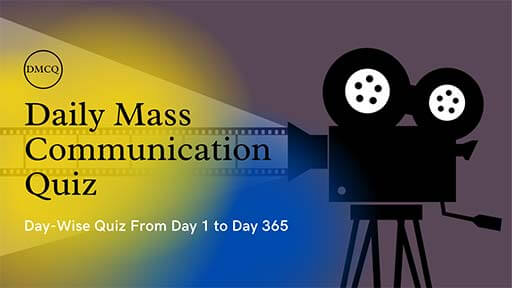Journalism and Mass Communication Objective Questions (DMCQ)
Q1. Editorials means ………………
(a) Writer’s reporting and his conclusions
(b) Unsigned articles that express a publication’s opinion
(c) Watching and listening where news is taking place
(d) Articles that any reader can add to or change
Correct Answer: (B) Unsigned articles that express a publication’s opinion
Explanation- Editorials are opinion pieces written by the editorial board of a publication. They reflect the official stance of the publication rather than an individual writer’s viewpoint.
Q2. The Guardian, formerly known as The Manchester Guardian founded………….., is a British national daily newspaper in the Berliner format.
(a) 1811
(b) 1821
(c) 1856
(d) 1878
Correct Answer: (B) 1821
Explanation- The Guardian was founded in 1821 as The Manchester Guardian. It has since evolved into a major British daily newspaper.
Q3. Who ………….had edited the “Mercurius Politicus” under Oliver Cromwell.
(a) John Milton
(b) Mahatma Gandhi
(c) Sir Richard Steel
(d) Joseph Addison
Correct Answer: (A) John Milton
Explanation- John Milton, the famous English poet and intellectual, edited “Mercurius Politicus,” a government-supported newspaper during the English Commonwealth under Oliver Cromwell.
Q4. In 1784, ……………launched the “Daily Universal Register” from London which later adopted a new name “The Times”.
(a) Francis Xavier
(b) John Walter
(c) Johann Carlous
(d) James Asher
Correct Answer: (B) John Walter
Explanation- John Walter founded the “Daily Universal Register” in 1784, which was later renamed “The Times” in 1788, becoming one of the most influential newspapers in the world.
Q5. Photography was developed in the 19th century by two people from…………, Nicephore Niepce and Louis- Jacques-Mande Daguerre.
(a) Italy
(b) Germany
(c) France
(d) Netherlands
Correct Answer: (C) France
Explanation- Nicéphore Niépce and Louis-Jacques-Mandé Daguerre, both from France, were pioneers in the development of photography in the early 19th century.
Q6. The first printed book published in China was the Buddhist text, the “Diamond Sutra” by……………….in 868 AD.
(a) Wang Chick
(b) David Henry
(c) Edward Cave
(d) Richard Cave
Correct Answer: (A) Wang Chick
Explanation- The “Diamond Sutra,” printed in 868 AD, is the earliest known printed book, and it was produced in China by Wang Chick.
Q7. The author of “The Jungle Book”, Rudyard Kipling, started ………….in 1866 from Allahabad.
(a) The Statesman
(b) The Times of India
(c) The Amrita Bazar Patrika
(d) The Pioneer
Correct Answer: (D) The Pioneer
Explanation- Rudyard Kipling, although not the founder, contributed to “The Pioneer,” an English-language newspaper started in Allahabad in 1866.
Q8. Henry Muddiman had gained eminence as the “journalist” who edited the …………in 1666.
(a) London Gazette
(b) Madras Gazette
(c) Kannada Samachar
(d) The Times of India
Correct Answer: (A) London Gazette
Explanation- Henry Muddiman was a significant figure in early journalism and edited the “London Gazette,” one of the first official newspapers in England.
Q9. ……………Hungarian-born editor and publisher, was instrumental in developing ‘yellow journalism’ in the United States.
(a) Joseph Pulitzer
(b) Nicholas Bourne
(c) Thomas Archer
(d) Benjamin Franklin
Correct Answer: (A) Joseph Pultizer
Explanation- Joseph Pulitzer, originally from Hungary, was a key figure in the development of “yellow journalism” in the United States, characterized by sensationalism and exaggeration to attract readers.
Q10. The renowned poet ………….’s Areopagitica, written in 1644, is the earliest extended essay on the FREEDOM OF THE PRESS.
(a) John Milton
(b) Shakespeare
(c) Keats
(d) Shelly
Correct Answer: (A) John Milton
Explanation- John Milton’s “Areopagitica” is one of the earliest and most famous essays advocating for freedom of the press, written as a defense against censorship.













